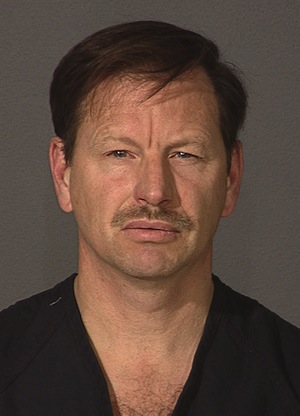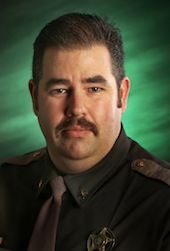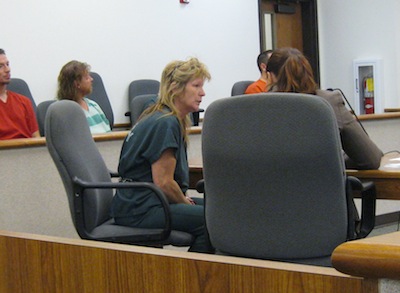
Gary Leon Ridgway’s mugshot is among the materials inside three unsolved case files at the Lewis County Sheriff’s Office.
By Sharyn L. Decker
Lewis County Sirens news reporter
CHEHALIS – Finally, more than a decade after his convictions for the murders of dozens of women in King County, serial killer Gary Ridgway was interviewed about three homicide victims whose bodies turned up along the Interstate 5 corridor in Lewis County.
Longtime Lewis County Sheriff’s Office detective Bruce Kimsey isn’t writing him off as a viable suspect, but Ridgway didn’t confess.
“When I asked him an hour’s worth of questions on the victims, he denied it and said, why would I take someone to Lewis County,” Kimsey said. “I’m not saying I believe him; I’m just saying what he said.”
Kimsey traveled to the U.S. Penitentiary in Florence, Colorado at the end of September. He was joined by Lewis County Prosecutor Jonathan Meyer and Senior Deputy Prosecutor Will Halstead for the two-day visit.

Chief Criminal Deputy Bruce Kimsey
They were only allowed to bring a pen and paper into the room. The serial killer had handcuffs chained to his waist. On the first day he wore leg irons as well, Meyer said.
“We spent several hours both days, four to six hours each day,” Meyer said. “There wasn’t a clock in the room, I didn’t have my watch.”
Meyer said they’ve been trying for several years to meet with Ridgway, and the answer before from his attorney had alway been no. When he got a yes answer, they jumped at the opportunity right away, he said.
The victimology in the three local cases is such that Ridgway has been a suspect, alluding to patterns in who Ridgway targeted.
Both Kimsey and Meyer took note of how short the infamous killer was.
“I expected him to be more physically imposing,” Meyer said. “He’s kind of meek, mild-mannered. He doesn’t have, ‘this guy’s gonna attack me’ vibe.”
It’s easy to see how someone would get into a truck with him, Meyer said.
The Auburn resident was convicted of murdering 49 women, but has admitted to killing 80, Meyer said. He was arrested in December 2001, at age 52.
There’s no physical evidence tying him to the Lewis County cases, and Ridgway didn’t have any particular facts about the three, the prosecutor said.
And at one point, he suggested he wouldn’t mind taking credit to “get his numbers up.”
“He understands what he’s done, and I think he likes the notoriety,” Meyer said. “He told us, there’s more written about me than Jack the Ripper.”
Much of their time was spent building rapport, talking about his work, marriage and hobbies and then after that, learning details about the crimes he committed in King County.
Ridgway worked at Kenworth for 30 years. He was married three times.
He became known as the Green River Killer, because that’s where some of the first bodies were discovered, Kimsey said.
That’s one of the similarities between the women he’s admitted to killing, and the women whose bodies were discovered locally starting in 1984, according to the detective.
Two of the bodies in Lewis County were found near waterways, he said. Two of the three had ties to prostitution, like Ridgway’s victims, according to Kimsey. And some of the known Green River victims went missing from the same area as did the women found in Lewis County.
What they do know for sure, is the three women were murdered and their bodies were discovered in Lewis County, Meyer said.
On August 12, 1984, Monica Anderson, 32, of Tacoma, was found by a fisherman in the Chehalis River west of Centralia below the Galvin Road bridge. She was last seen June 25 in Tacoma, getting into a brown van on Commerce Way. She died of asphyxiation, Kimsey said.
On May 5 1985, Susan L. Krueger, 42, was found along Lacamas Creek at Drews Prairie Road near Interstate 5 west of Toledo. She was last seen March 11 after she was released from the Pierce County Jail. She died of blows to the head.
On August 5, 1991, Mignon S. Hensley, 21, was found in a brushy area about a mile east of Interstate 5 along U.S. Highway 12. She was last seen June 19 leaving a Deja Vu strip club in Federal Way. She was about eight months pregnant at the time. She died from homicidal violence.
Kimsey, who was promoted to chief criminal deputy when newly elected Sheriff Rob Snaza took office in January has studied the three case files.
“I would say a reasonable person would say there was sexual assault, or sexual motivation on these crimes,” Kimsey said of the evidence.
Ridgeway indicated to his interviewers he had nothing to do with the three deaths and that it wouldn’t make sense for him dump a body in Lewis County.
Part of Ridgway’s crimes involved returning to the dump sites to visit the bodies, and engage them sexually again, according to Kimsey.
He knew King County like the back of his hand, and said, he wouldn’t go to Lewis County and screw it up, Meyer said.
But, Ridgway did take some of his victims from King County all the way to Oregon, Kimsey said. He told his three interviewers he took bones down there after digging them up, to get the FBI involved and throw off the Green River Task Force.
They three men spent some of their time orienting Ridgway to the boundaries of Lewis County, and learned he’d been to Yard Birds and the the Centralia Outlets.
When the conversation turned to Ridgway’s time in the Navy, overseas, Ridgway’s comment was, “that would open up a can of worms,” Meyer said. A person could speculate about what that means, he said.
“Ridgway will say every one of his victims, he strangled,” Kimsey said.
The takeaway for Kimsey, is what he learned about what Ridgway did to his victims, for example, details of how he left the bodies, Kimsey said.
“I’m going to go back and look again at our cases to see if they match up, if there’s some matchup,” he said.
Meyer said he left feeling like Ridgway would readily admit if he’d killed the women, but then wonders, if he says there’s 80 victims, does he remember every one?
Kimsey has the same question.
“The problem, is he doesn’t remember names and faces,” Kimsey said. “He said he lost count after like two dozen.”
The detective asked one of the most infamous serial killers ever why he did what he did.
“He told us he felt a sense of power over women, and why he didn’t like these women,” Kimsey said. “He saw prostitutes as basically trash.”
He knew the women he victimized weren’t likely to be reported missing, at least not right away, and, he didn’t have to pay them, Kimsey said.
It was almost like a game, where he could take out his negative energy, Kimsey said.
“The things that he’s saying, no normal person could understand,” Kimsey said. “It’s pure evil and horrific, the things he’s done to women.”
Kimsey, Meyer and Halstead also spoke with Ridgway about the unsolved homicides of two other women during the same time period. Kimsey said he doesn’t think he was involved in their deaths.
Roberta D. Strasbaugh, 18, was found October 18, 1985 on the north side of Lincoln Creek Road at its junction with Manner’s Road, about three weeks after her truck ran out of gas along Old Highway 99.
Diana Robertson’s body was found in 1986, about three miles south of Elbe.
It’s obvious there’s been more than one serial killer operating in the region, Kimsey said.
One of them, Robert L. Yates is also on Kimsey’s list to talk with, although he’s a serial killer with limited activity in Western Washington, and Kimsey said he believes his victims were shot with a firearm.
The goal is to get answers, for families who don’t know what happened to their loved ones, according to Meyer.
For Kimsey, continuing to work the cases is a duty owed to their families. He’ll keep going through the files, trying to match some evidence to a suspect, he said.
Ridgway is not eliminated as a suspect, and certainly not based on his denials, according to the detective.
“I’m not convinced he has nothing to do with these, I’m not convinced he does,” Kimsey said. “I’m going to take the information and keep working these cases.” “Maybe the technology one day will be there.”





 Join us
Join us